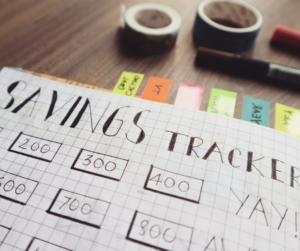There are plenty of reasons to save money, but a big vacation is arguably the most exciting incentive. After all, “I’d love to travel more” is one of those New Year resolutions pretty much everyone makes.

We usually start out with a decent budgeting effort (hello, Dry January), but as the year rolls on, our spending inevitably becomes harder and harder to keep in check. To make sure that you’re able to make a healthy contribution to your travel fund every month, we’ve tapped two budgeting experts to devise a 12-month saving plan that’s super easy to follow. Each month, you’ll be challenged to give up or change an everyday habit, and we’ve provided rough estimates on how much extra savings can go towards your planned journey, whether it’s an epic Eurotrip or backpacking jaunt through Southeast Asia.
Reassess Your Monthly Bills
The start of a year is a great time to kick things into motion — and start paying attention to your monthly bills. “Try to identify areas of redundancy that you can just cut back,” says Kimmie Greene, a consumer finance expert at Mint, a personal finance and budgeting app. “For example, if you have a Spotify account, you can switch to a family plan and split the cost with your family members or a few friends.”
Grab a magnifying glass and really pore over your monthly bank statements. Not only is it a great way to figure out what spending areas you should be trimming, it’s also an opportunity to flag any subscription-based services that you no longer have a need for, such as premium membership on dating apps.
One no-brainer step you should already be doing? Pay all your bills online. It’s a lot more convenient, and you’ll be saving on postage. If you pay 10 bills a month, eliminating $.49 stamps over the course of 12 months will save you $58.80.
Go Low-Key On V-Day
Valentine’s Day is one of those special occasions that can be a massive drain on your savings. Flowers and chocolates tend to be more expensive around this time of the year due to increased demand, not to mention skyrocketing costs if you choose to dine out.
Skipping the bouquet-and-chocolate combo can save you around $75 right off the bat, according to Len Hayduchok, a CFP and president of Dedicated Financial Services. Opt for a nice hand-written note — paired with an inexpensive but thoughtful gift — to avoid racking up high expenses. If you’re flying solo on V-Day, throwing a popcorn-and-movie gathering with your best buds will keep things cheap and cheerful.
Reduce Dining Out By Half
You probably already know this, but eating in is a big money saver. By being smart about meal-planning, you can still eat out without breaking the bank. Greene suggests cutting the number of times you dine out in half to eliminate unnecessary costs. “The average person spends around $232 per month ordering takeout and dining at restaurants,” she says. “By reducing this in half, you can save yourself $116 a month.” Check out our big roundup of packed lunch recipes for culinary inspiration.
Take Alternative Transportation
If walking to work is an option, try challenging yourself to a whole month of commuting on foot — since the weather is generally pleasant this time of year. If you drive to work, try mapping out an alternative route on public transportation. “If you can commit to a more economical method of getting around for an entire month, you should be able to set aside $100 to $200 at the end of that month,” says Greene. Obviously, this depends on the type of car you drive, parking costs, and the length of your daily commute, but you’d be killing multiple birds with one stone — it’s better for the environment and you’re getting some extra work out.
Cut The Cord
Part ways with your cable provider to save a buck, since most of the things you’d want to watch is on Netflix and Amazon Prime anyways. Depending what cable company you’re with, you can save an average of $110 a month, according to Greene.
If you’re not reading to bid adieu to your TV channels, try bargaining your way to a better deal. Broadband and phone bundles often charge a lot for services you might not even need, such as a landline or a surplus of TV channels. Contacting a customer service rep at your current provider and negotiate for a discount. (Threatening to leave helps.)
Watch Your Power Consumption
“Take a look at your electric bill and ask yourself: Can you handle cutting back on the AC or heat?” says Hayduchok. Work towards a lower energy bill by installing a programmable thermostat, so the heating and cooling functions are turned off when you’re at work or asleep.
Better yet, install a ceiling fan and back off on the AC: It can potentially save you an average of $128 each month, according to figures published on 20somethingfinance.com
Collect Your Spare Change
This savings trick doesn’t take much effort, but not many people actually do it: Start collecting all the spare change you’re given after purchases. While you’re at it, do a quick scan under your couch, cushions, and car seats for loose coins: You’d be surprised at how much money you’ll find. Another hack that helps you set aside money without even thinking about it? Greene recommends setting up a daily transfer of $1 from your checking account to your savings account. Even if you’re just putting away $1 a day, it will amount to $365 at the end of the year.
Get Coupon-Savvy
Sure, couponing doesn’t sound like a sexy way to budget your spending, but it can make a huge difference, especially considering that the average household spends an upwards of $4,000 on groceries every year. “Take some time out of your day to research coupons, from Groupons to delivery deals — anything that make sense for your lifestyle,” says Greene. “These small discounts can help you save an average of $5 a day on groceries, which adds up to $150 a month.”
Get Creative With Workouts
A pilates class may help get those endorphins going, but that expensive gym membership isn’t doing your bank account any favors. Membership fees in big cities like L.A. or NYC can rack up over $100 a month, according to Greene. “If you’re not really taking advantage of your gym, cancel your membership and find a more affordable way to work out instead,” she says. “Running outdoors, doing routines at home, or pursuing trial day passes are the way to go.”
Another thing you can possibly cut back on: buying bottled water after a class. Bring a reusable bottles at the gym helps reduce waste and unnecessary spending. By Greene’s estimates, an average person spends roughly $100 a year on bottled water. You can save yourself at least $8.33 a month by skipping the plastic.
Go Easy On Thanksgiving Dinner
The more indulgent the feast, the higher the expenditure: Instead of going all out on your Thanksgiving dinner, look up ways to do more with less. Skip the whole bird and invest in just breast or drumsticks for half the price. Repurpose the frozen rolls and sliced bread in your freezer into side dishes. Get boxed wine and serve it in a fancy decanter. According to Hayduchok, you can save at least $20 per person by cutting back to normal portions. Check our more of our tips here on how to throw a Turkey Day dinner party on the cheap.
Delay Your Gifts
We’re often tempted to spend more around the holidays. To counter that urge to drop more money than you should on gifts, Hayduchok suggests doing things a little differently this year. “Try to do your holiday shopping right after the holidays, when Day-After-Christmas deals are in place,” says Hayduchok. “While you’re at it, stock up on essentials you may need next year, such as wrapping paper, bows and gift bags — while they are on clearance.” Waiting an extra couple of days to unveil your presents is going to be so worth it.
Originally Published: YahooFinance
New Year's Savings Habits New Habits for the New Year Saving Habits_Yahoo Finance, Jan 2019








